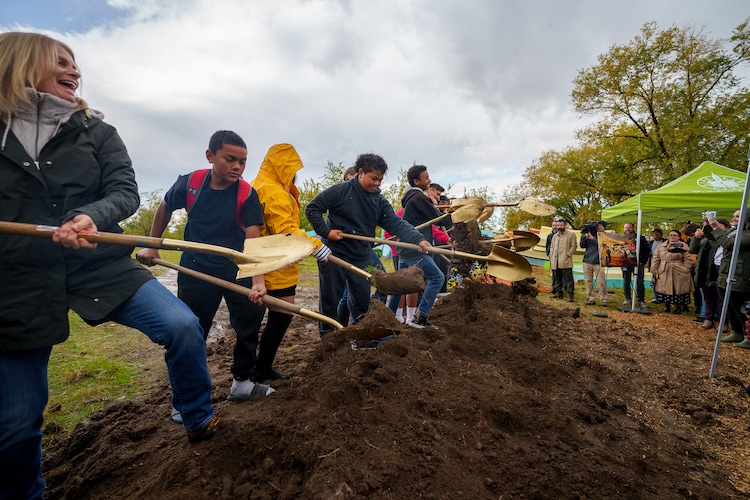Students and Salt Lake City officials turned the first dirt at the old Raging Waters water park Thursday, moving the largest park the city’s west side has ever seen closer to reality.
The Glendale Regional Park is designed, city officials say, to be the west side’s version of the city’s major parks — Liberty Park and Sugar House Park.
But, Salt Lake City Mayor Erin Mendenhall said at Thursday’s groundbreaking event, “this is the first regional park in Salt Lake City’s history that will truly be built by community inspiration.”
The regional park — connected to nearby Glendale Park, 17th South River Park, Glendale Golf Course and the Jordan River Parkway — is set to become a major 17-acre attraction.
The cost for the park could run between $30 million and $50 million, Public Lands planner Kat Maus said in March. Voters in 2022 approved a general obligation bond, which included $27 million to fund the park’s planning and construction.

(Trent Nelson | The Salt Lake Tribune) Students from Glendale Middle School participate in the groundbreaking ceremony for the new Glendale Regional Park in Salt Lake City on Thursday, Oct. 26, 2023.
Neighbors and schoolchildren showed up to the groundbreaking, many of them expressing excitement that they could walk there — and happy that the former site of the water park won’t be sitting empty any more.
Linda Ika Tupou, a longtime Glendale resident, brought her granddaughter, Kasinga Faletau, a Glendale Middle School student. Ika Tupou said she can’t wait to see pickleball courts available; right now, she and her neighbors have been playing at the courts of their nearby church.
“We want it to happen fast,” she said, “so we can use the pickleball courts and the things for the kids, all those things.”
Faletau, 14, is looking forward to the splash pad that’s on the vision plan — and, more importantly, to having the park as a gathering space. She said she’s excited about “just having a place to play with my family.”
“This is a big deal,” said Alejandro Puy, District 2 council member, who represents the Glendale neighborhood. “Good things happen on the west side. We need to celebrate these things. We deserve good things.”
(Trent Nelson | The Salt Lake Tribune) Salt Lake City Council member Alejandro Puy speaks at the groundbreaking ceremony for the new Glendale Regional Park in Salt Lake City on Thursday, Oct. 26, 2023.
For Turner Bitton, chair of the Glendale Neighborhood Council, this park represents a generational shift.
“As I think about this process, I think about the very many different neighbors that came out and raised their voice about what they wanted to see at this park,” Bitton said. Those included people who loved Raging Waters, the children who helped shape the park’s vision with their drawings, and community groups — like the Die Hard Pickleballerz, a league that has advocated for pickleball courts in west-side neighborhoods.
“We need this in our community space, and the west side deserves nice things,” Bitton said. “And what I really envisioned for Glendale Regional Park is that this is going to be the heart of a neighborhood that’s on the rise, and the heart of a west side that’s on the rise.”
Building the park will take a few years. The first phase is expected to be open next summer, on the west part of the site, adjacent to Glendale Neighborhood Park. Plans for this phase include an all-abilities playground with assistive technologies, a basketball hoop, a pavilion, pathways, a community plaza and lawn for picnics and other activities.
(Design Workshop | Salt Lake City) Rendering of features included on the Glendale Regional Park Vision.
The park, Mendenhall said, will be a place for children and adults to play — an important benefit in a city that saw a 42% increase in park and trail use during the COVID-19 pandemic, she said.
Next phases will also include pickleball courts, access to the Jordan River, a boat dock, a kayak rental station, a dog park, a skating ribbon, a kids climbing feature and promenades. There also are plans, eventually, for an outdoor pool — something residents overwhelmingly requested during the city’s engagement sessions, as a replacement for Raging Waters, which was a wildly popular summer cooling spot before it fell into disrepair.
Pieces of the old water slides from Raging Waters remain on the site. That’s on purpose, Mendenhall said, as the city aims to incorporate them into the park’s design — and will seek input from the community and from artists to define how.
This is the first regional park built in Salt Lake City in more than 60 years, Mendenhall said. (Liberty Park was established in the 1920s and Sugar House Park was built in the 1950s.) It’s also the first park of this size in the west side.
“We know in Salt Lake City equality and equity are not the same thing. And our investments historically have not been equitable enough,” Mendenhall said. “We’re changing that in part with this investment.”
(Design Workshop | Salt Lake City) Rendering of features included in the first phase of the Glendale Regional Park plan.
Alixel Cabrera is a Report for America corps member and writes about the status of communities on the west side of the Salt Lake Valley for The Salt Lake Tribune. Your donation to match our RFA grant helps keep her writing stories like this one; please consider making a tax-deductible gift of any amount today by clicking here.


